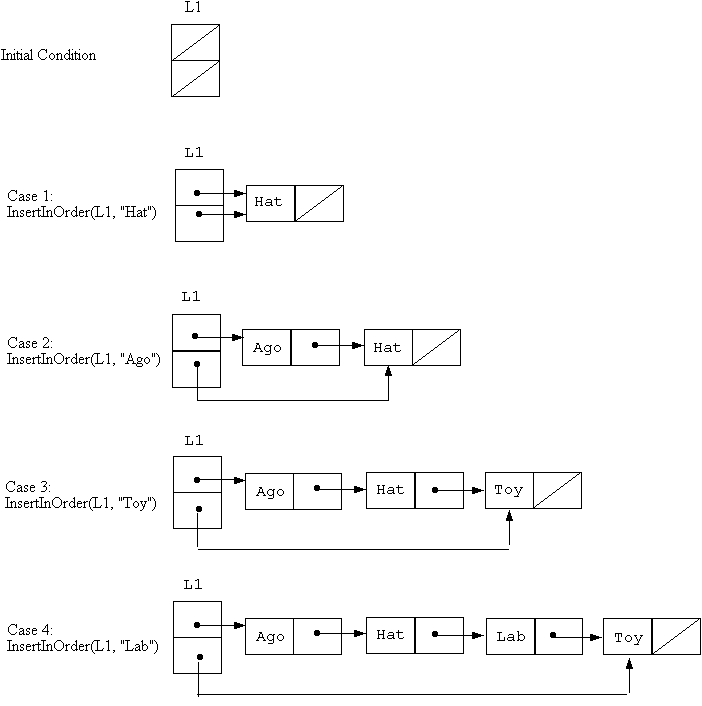
A linked list is often used as an implementation for an ordered sequence of elements which appear in order according to some key. This can be thought of as a linked list analogy to a sorted array. It is therefore important to understand how to insert a new value into a linked list that is already sorted.
The insertion process has four distinct cases:
For the list representation we have been using, these four
cases are illustrated in
Figure
14.7. A iterative procedure InsertInOrder is shown as
Program
14.10. We leave it to you to develop a recursive version, which you will
find to be a much simpler procedure.
Figure 14.7
Program 14.10
Ordered Linked List Insertion
SEPARATE (Singly_Linked_Lists)
PROCEDURE InsertInOrder (L: IN OUT List; Word: IN WordType) IS
------------------------------------------------------------------------
--| Iterative implementation of InsertInOrder;
--| if Word already in list, second occurrence must follow first one
--| Author: Michael B. Feldman, The George Washington University
--| Last Modified: September 1995
------------------------------------------------------------------------
Current: ListPtr; -- designates each node of input list in turn
Previous: ListPtr; -- trailer - one node behind Current
Temp: ListPtr; -- holds pointer to newly allocated node
BEGIN -- InsertInOrder
IF L.Head = NULL THEN -- case (1)
AddToFront (L, Word);
ELSIF Word < L.Head.ALL.Word THEN -- case (2)
AddToFront (L, Word);
ELSIF Word >= L.Tail.ALL.Word THEN -- case (3)
AddToEnd (L, Word);
ELSE -- case (4)
-- at this point, we know L not empty and
-- first word <= Word < last word
Temp := NEW ListNode'(Word, NULL);
Previous := L.Head; -- first node
Current := Previous.ALL.Next; -- second node, if any
WHILE Word >= Current.ALL.Word LOOP
Previous := Current;
Current := Current.ALL.Next;
END LOOP;
-- assert: Previous.ALL.Word <= Word < Current.ALL.Word
-- insert new node between Previous and Current
Temp.ALL.Next := Current;
Previous.ALL.Next := Temp;
END IF;
END InsertInOrder;
Notice
how the each of the four cases is handled; only case 4 requires a search
through the list. Note also that two pointers are used to search the list
because the new node is inserted between two others, in this case those
designated by Previous and Current, respectively.
Make sure you understand exactly how the procedure operates by tracing its
actions on the example cases shown in the figure. This succession of calls to
InsertInOrder builds and maintains a sorted list.
Copyright © 1996 by Addison-Wesley Publishing Company, Inc.